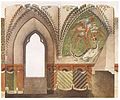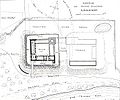Lochstedt Castle
| Lochstedt Castle | ||
|---|---|---|
|
Reconstruction drawing |
||
| Alternative name (s): | Lochstädt Castle, Pavlovo Castle |
|
| Castle type : | Niederungsburg | |
| Conservation status: | Burgstall | |
| Standing position : | Ordensburg | |
| Place: | Pavlovo | |
| Geographical location | 54 ° 42 '25.3 " N , 19 ° 57' 4.6" E | |
|
|
||
The castle Lochstedt even castle Lochstädt written was an art history major Ordensburg of the Teutonic Order in the then East Prussian village Lochstädt today Pavlovo . It was supposed to control the access to the Frischen Haff , but it soon became irrelevant. Only through the constant use of the Lochstedt castle chapel was the castle initially spared demolition. Although its interior had suffered from war and external use, it remained largely unchanged until its destruction in 1945 and in the 1960s.
history
- see also Lochstedt Castle Chapel

After the Teutonic Order had reached Balga and established it as a base, it took a while until it could gain a foothold on the Samland with the help of Ottokar II Přemysl . Before that, the Prussian Luxete Castle stood there at the beginning of the Fresh Spit . The name Lochstedt was therefore possibly derived from the Samland country noble Laucstiete. Another option is to start at a low; H. Hole = deep. Not far from the castle, the Schönewik bishop's castle, later Fischhausen, was also built on the banks of the Haff.
The castle existed as a wood wall system until 1270 and was made of stone from 1275 to 1285. The south wing with the castle chapel is the oldest part. To the west of it was a narrow vestibule, and then the remter followed for the rest of the wing . The west wing contained smaller, late Gothic vaulted rooms. But as early as 1311, when the convent house was built, the Lochstädter Tief began to sand up and the Pillauer Tief was formed. With this, the castle also lost its strategic importance; only the amber office of the amber master, who was subordinate to the large shepherd in Königsberg, still gave the castle a certain value. The Komtur was given up, and from then on Lochstädt was the seat of a keeper of the Komturei Königsberg , who held the amber shelf until the end of the order .
Probably the most famous nurse was Heinrich von Plauen , who after his fall as Grand Master spent the last years of his life here from 1422 until his death in 1429.
“... he came to Lochstedt in 1422 for better treatment. But, as is known from his letters, his lot was still very hard; there was a lack of essentials, clothing and even food. "
In 1429, half a year before his death, he was appointed carer for Lochstedt.
Shortly before the end of the state of the Order, 700 Swedish mercenaries who hurried to the aid of Grand Master Albrecht were housed in Lochstedt during the equestrian war . After that the castle deteriorated more and more. As early as 1512, the Grand Master was reported to be in serious disrepair, and in 1603 a captain Paul noted the thick walls and the strength of the tower, although the roof was already missing. He still thought the castle would be a strong fortress if the damage was repaired.
When Gustav Adolf landed in Pillau on July 6, 1626 during the Polish-Swedish War , the castle was used by the Swedes as a base on this train, and much of the harsh Soldateska was destroyed. When this then withdrew, earth walls were built in Lochstedt for defense, whereupon Gustaf Adolf attacked Lochstedt on his return the following year. However, there was no bloodshed; the Prussian troops withdrew in time. The castle now served the Swedes as a base during the Thirty Years' War and into the second half of the 17th century.
In a report from 1664, Lochstedt is described as very dilapidated. When St. Adalbert's Church in Tenkitten collapsed on November 24, 1669 because of dilapidation, the Tenkitten service was relocated to the nearby Lochstedt castle chapel , in order to be celebrated in the castle chapel until 1945. This circumstance should have saved the castle from complete demolition, because after the ruinous coronation of Frederick III. From Brandenburg Friedrich I to King in Prussia, he decreed in March 1705 that the offices of Fischhausen, Balga and Lochstedt should tear down circular walls and unusable buildings in order to gain the building material for the Pillau fortress . According to general opinion, this arrangement in Lochstedt fell victim to the north and east wings as well as the tower, the demolition of which must have occurred between 1701 and 1702 according to the official registers. Nevertheless, in his Prussian regional studies from 1713 , John von Collas describes the castle complex as a four-wing main house with a tower and outer bailey. It is believed that he made his recording shortly before the cancellation.
When East Prussia was occupied by Russian troops during the Seven Years' War , it was Nikolaus Friedrich von Korff who, in his capacity as Russian Governor General of Königsberg , bought Lochstedt back for the state and had the interior of the chapel redesigned - not exactly happy - in 1760 . At the end of the Fourth Coalition War from 1807 to 1809, the French General Louis-Vincent-Joseph Le Blond, Comte de Saint-Hilaire and his occupation troops moved into quarters there. After the Peace of Tilsit , the Prussian state sold the rest to a private individual in order to be able to service the contributions. After about half a century, Prussia was able to regain ownership of the property by buying it back.
In the second half of the 19th century, the free rooms were used as a royal forester's apartment (1888) in the rooms of the amber master, as a school (1891) and as the East Prussian Museum of Local History. After Conrad Steinbrecht took stock of the complex , he recognized the great art-historical value of the complex. Adolf Böttinger also agrees with this - even before the frescoes were discovered - and continues to remark:
“The vault caps were provided with inscriptions, as could recently be seen under the thick whitewash [...] If you are in Königsberg, you shouldn't shy away from the one-hour drive to Lochstedt. Now (1890) a school is to be built in the building; hopefully nothing will be changed "
In 1895 the frescoes in the territorial chambers were freed from the overlying layer of lime: unique sculptures came to light again after centuries. But it was not until 1937 that it was secured and restored. A wooden gallery with part of the cloister was reconstructed on the courtyard side.
At the end of the Second World War , the half-height south wing with the gateway and sacristy as well as the west wing remained intact, as the photos from 1948 prove. In the 1960s it was demolished down to the foundation walls. It is believed that they were looking for the Amber Room . Writings by Kristijonas Donelaitis and other documents were found in the vaulted cellar . Some bricks are exhibited in the Germanic National Museum in Nuremberg and some remains of capital in the lapidarium of the Marienburg. The Photo Archive Photo Marburg still has some photos of the medieval order castle.
The decorative design
“Even the doorway surprises you in a niche framed by different colored bricks, the rounded, profiled pointed arch decoration with inscribed half quatrefoils on elegantly shaped consoles. The main splendor of such decorative subtleties unfolds on the courtyard side of the chapel wing, especially on the portals. The profiles of their robes play in rich, rounded movements, shimmered over by the colored glitter of the brightly glazed bricks. "
Frescoes
“When looking at the Lochstedt picture cycle, it becomes clear again and again that it is not, as is so often the case, based on an obsolete and perhaps already dead program, but rather that it is linked to multiple relationships with the life and views of the castle residents. In view of the subtle artistic content and the high quality, one would like to know who was the painter of this great picture book that is open on the walls. But no chronicle, no document mentions him. "
Little Komturremter
- The Archangel Michael slays the dragon
- Annunciation
- Christ and the adulteress
- The resurrection
- Abraham's sacrifice and the giving of the tablets of the law to Moses
- Saint Christopher
- The crucifixion of Christ
The little room next door
- Saint George
- The adoration of the Magi
The rectangular remter
- The nine good heroes
- The order banners
photos
Web links
literature
- in order of appearance
- Leopold Krug : The Prussian Monarchy; presented topographically, statistically and economically. According to official sources . Part I: Province of Prussia . Berlin 1833, p. 134, paragraph 7.
- August Eduard Preuss : Prussian country and folklore or description of Prussia. A manual for primary school teachers in the province of Prussia, as well as for all friends of the fatherland . Bornträger Brothers, Königsberg 1835, p. 500.
- Karl Emil Gebauer : The Ordenshaus Lochstätt ( A contribution to the more precise customer of the Samland ). In: Prussian provincial sheets . Volume 19, Königsberg 1838, pp. 1-16 and pp. 127-144.
- Karl Emil Gebauer : Customer of the Samland or history and topographical-statistical picture of the East Prussian landscape Samland . Königsberg 1844, pp. 96-97.
- Adolf Boetticher, Architectural and Art Monuments of the Samland, Königsberg 1891
- Conrad Steinbrecht: The architecture of the German order of knights in Prussia - Vol. 3, Lochstedt Castle and its paintings . Springer, Berlin 1910.
- Karl-Heinz Clasen : The Deutschordensburg Lochstedt, Königsberg 1927
- Tomasz Torbus: The convent castles in the Teutonic Order of Prussia . Oldenbourg, Munich 1998, ISBN 3-486-56358-0 , pp. 111-116, 476-486, doi: 10.11588 / diglit.43361 .
Individual evidence
- ^ Karl-Heinz Clasen: Die Deutschordensburg Lochstedt, Königsberg 1927 p. 9
- ^ Die Deutschordensburg Lochstedt, Königsberg 1927 p. 13
- ^ Karl-Heinz Clasen: Die Deutschordensburg Lochstedt, Königsberg 1927, pp. 14-15
- ^ Karl-Heinz Clasen: Die Deutschordensburg Lochstedt, Königsberg 1927, p. 16
- ↑ Architectural and art monuments of the Samland, Königsberg 1891 p. 77 u. P. 79
- ^ Pictures from Lochstedt
- ^ Ostpreussen.net
- ^ Die Deutschordensburg Lochstedt, Königsberg 1927 p. 39
- ^ Die Deutschordensburg Lochstedt, Königsberg 1927 p. 50













